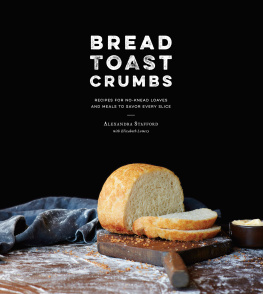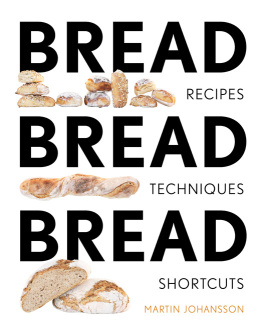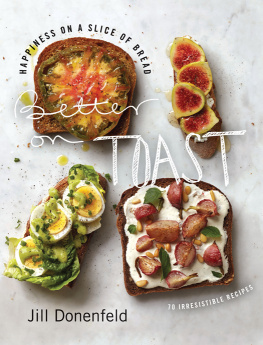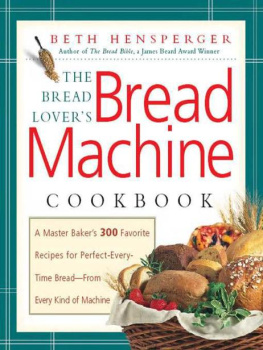FAQ
Can I use active dry yeast?
If you do choose to use active dry yeast, heres how: In a small bowl, dissolve the sugar into the water. Sprinkle the yeast on top. Let it stand for 10 to 15 minutes or until the mixture is foamy; there is no need to stir it up. Meanwhile, in a large bowl, whisk together the flour and salt. When the yeast mixture is foamy, stir it up and add it to the flour. Using a rubber spatula, mix until the liquid is absorbed and the ingredients form a sticky dough ball. Proceed with each bread recipe as written.
To adapt any other recipes to active dry yeast, be sure the liquid ingredients are lukewarm. Dissolve the yeast into the lukewarm water with a teaspoon of the sweetener (whatever is being called for: sugar, honey, molasses, etc.). Let it stand for 10 to 15 minutes, or until the mixture is foamy; there is no need to stir it up. When the mixture is foamy, combine it with the dry ingredients, and proceed with the recipe as written.
Why doesnt my bread rise as high as the loaves in your photos?
The biggest culprit is the vessel. See for advice regarding baking equipment.
The second culprit is over-rising. The first rise should take 1 to 2 hours. For the second rise, let the dough rise only until it crowns the rim of the bowl or loaf panit will spring higher in the oven. If the dough begins spilling over the edges of the vessel during its second rise, deflate it with forks, and let it rise again.
Why do rising times vary so dramatically?
Many variableshumidity, water temperature, flour, yeast, environmentaffect the dough you mix, and every day these factors change. In the summer, your dough may rise in 1 hour; in the winter, it may take as long as 2. Second rises, too, may take 10 minutes when it is warm out; they may take 25 minutes when its cold. For the first rise, a slightly warm oven will help the dough rise nicely no matter the conditions outside (see ).
Why do you bake the bread initially at 425F, then reduce the heat?
Starting the baking off at a higher temperature encourages the dough to spring in the oven. Lowering the temperature after 15 minutes ensures the loaves dont brown too quickly.
How should I store my bread? How should I reheat my bread?
See .
Can you mix the dough at night and bake it in the morning? Or mix the dough in the morning before work?
Yes. See .
Can you bring the dough to a party and bake it on the premises?
Yes. See .
Is there a vegan substitute for butter for greasing the bowls?
Yes. See .
Can I double the recipe? Halve it?
Yes. When doubling, however, 3 teaspoons of instant yeast will suffice. When halving, use 1 teaspoon instant yeast.
I find using forks tricky to lift the dough into the bowls. What else can I use?
Flexible bowl scrapers (also called dough scrapers or bench scrapers) work well for portioning and scooping dough. Otherwise, try to use wide forks with short tines.
How can I make this bread more artisan?
If you equate artisan with a thick, bronze, crackling crust, the easiest way to adapt the to this style is to keep the proportions the same but to bake the dough in a preheated vessel, the genius method Jim Lahey introduced (via Mark Bittman and the New York Times) to the home baker in 2006. To give the Peasant Bread the Lahey treatment, while the dough is making its first rise (in a warm spot, but not your oven), preheat a Dutch oven for 45 minutes at 450F. Dust a clean surface with cup (32 g) flour. Turn the dough out onto the clean surface and shape the dough into a ball using the pinkie-edges of your hands to pinch the dough underneath, creating tension. Transfer the dough to a sheet of parchment paperthe use of parchment paper here is key, as it allows for a seamless transition from the counter to the preheated Dutch oven. After 20 minutes of resting on the counter, remove the Dutch oven from the oven, lower the Peasant Bread, parchment paper and all, into the pan, cover, and bake for 30 minutes. Uncover and bake for 15 minutes more.
If you equate artisan with a more porous crumb and a slight sour flavor, you can reduce the amount of yeast and extend the rise times. Simply use 1 teaspoon instant yeast and cold water in place of the boiling water. Let the dough rise overnight or for 10 to 12 hours at room temperature, then proceed with the recipe.
Alternatively, you can follow the recipe exactly, but let the dough rise in the fridge.
With either of these methods, the second rise may take as long as 1 to 2 hours.
If you equate artisan with using flour sourced from a local mill or flour milled at home, follow the .
Can I make bread without salt?
Yes, but the loaves will taste bland.
How can I give my loaves a shiny crust?
Make an egg wash: whisk 1 egg with 1 tablespoon of water. Brush this over the dough before baking.
How can I make dried bread crumbs if I dont have a food processor?
SLOW METHOD
Preheat the oven to 250F. Tear the bread approximately into 1-inch pieces. Spread them on a sheet pan and toast for 45 to 60 minutes, until very dry; the crumbs should take on very little color. Cool them completely on the sheet pan. Transfer the pieces to a resealable plastic bag and crush with a rolling pin or bash with a skillet. Store in an airtight container at room temperature for months.
FAST METHOD
Preheat the oven to 375F. Tear the bread approximately into 1-inch pieces. Spread them on a sheet pan and toast for 10 to 15 minutes, until evenly golden. Cool them completely on the sheet pan. Transfer the pieces to a resealable plastic bag and crush with a rolling pin or bash with a skillet. Store in an airtight container at room temperature for months.
Why do I need to dry the crumbs? Cant I just let them get stale?
Drying out the crumbs is preferable to staling because drying preserves the flavor. Antonietta Fazzone, a friends mother (see ), demonstrated this to me one day at her sink, where she ran a slice of bread she had dried out in the oven under the streaming faucet. She then broke off a piece for me to taste. Then, she ran a slice of stale bread under the faucet. She handed me that piece to compare, but there was no comparisonthe one she had oven-dried was the unmistakable winner. Toasting had preserved the flavor; staling had not.
TROUBLESHOOTING
My loaves have muffin tops.
Solution: Your dough has over-risen. Be sure your vessel is the requisite size. Next time, on the second rise, let the dough only crown the rims of the vessels before sticking it in the oven. If you get distracted and your dough has risen too highthat is, it is spreading over the sides of the bowlthen gently deflate the dough in the bowl and let it rise again.
My top crust is too dark.
Solution: Bake the bread on a lower rack or bake the loaves at a lower temperature: 375F for 40 to 45 minutes.
My bottom crust is too dark.
Solution: Bake the bread on a higher rack.
My loaf is pale all around.
Solution: If the loaves look pale after the recommended baking time, simply bake them longer, checking every 3 to 5 minutes. If this problem persists, consider buying an oven thermometer, which costs just a few dollars and will let you know the accuracy of your oven.
My dough is pourable.
Solution: Add cup (32 g) more flour. Continue adding flour in this manner until the dough forms a sticky ballremember, however, that the Peasant Bread dough is not stiff and tacky like kneaded bread dough. If you live in a humid climate, you may have better success reducing the liquid by 2 to 4 tablespoons. You will find, too, that as the seasons change, you may need more or less water.
My dough is stiff, and I cannot incorporate all of the flour.
Solution: Add water 1 tablespoon at a time, mixing until the dough forms a sticky dough ball and all of the flour is incorporated. Too much flour likely caused the dough to be stiff. If you are not using a scale to measure the flour, do this instead: use a fork to fluff up the flour in the bag, spoon the flour into your measuring cups, then level it off. This method will ensure each cup of flour measured will be on the lighter side.
Next page







